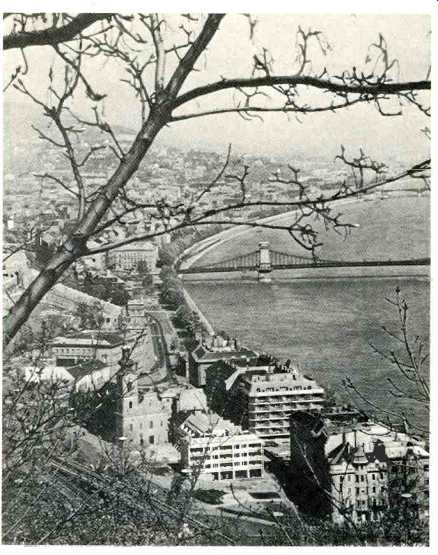
By George W. Tillett
Editor's Review
I HAD BEEN INTRIGUED by a series of advertisements for Hungarian loudspeakers appearing under the above heading in some trade journals and so, when I was invited to join a party visiting Hungary, I jumped at the chance to find out what "the people who brought us Franz Liszt" could have in store for us. (In passing, I notice that Deutsche Grammophon's European advertisements read "From the people who brought you Valhalla." It's up to the Italians now....) Anyway, before I bring you Hungary, I want to "make one thing perfectly clear." I have experienced both Fascist and Communist states at first hand and I dislike any form of totalitarian government.
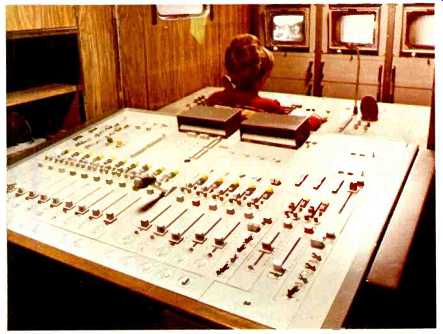
--------- Typical EAG control desk.
Our free enterprise system is far from perfect but it gives more freedom and a higher standard of living than obtains anywhere in the world. That said, I must say that I was pleasantly surprised to find more freedom in Hungary than I expected and, although there is no political freedom, the regime is probably more liberal (in the best sense) than any in Eastern Europe. The standard of living is low by our standards, but even so it is better than that in surrounding countries. Conditions have improved enormously since the abortive (counter--take your choice.) revolution of 1956 and Hungarians are now free to travel--a privilege granted to citizen groups in the Soviet Union. We stayed in Budapest which is a very beautiful city with many historical buildings. Much damage was caused during the war, but considerable rebuilding is in progress.
Unfortunately, all the shops--with the exception of tourist centers--close promptly at 6:00 p.m., after which the good people of Budapest are swallowed up by the subway and the yellow caterpillar-lines of streetcars, leaving the town as deserted as Philadelphia on a Sunday morning. Well, not quite because there are 14 theaters and a multitude of restaurants-and some night clubs! It is a city of contrasts--incredibly ancient public telephone boxes outside a streamlined modern bus station, an ultra-modern international-style hotel near gems of baroque architecture, and posters about America and Vietnam next to advertisements for Coca-Cola and the latest Streisand movie. In spite of anti-American propaganda (mainly confined to the Vietnam issue), I met nothing but friendliness and goodwill from people at all levels.
Every morning our party of 18 plus two interpreters were picked up at the crack of dawn by "Icarus 108-40" a comfortable bus which in due course decanted us at a factory. Here we would be greeted by the staff and, after sampling the wine, we would look at the production lines, laboratories, and so on. Most of the organizations made loudspeakers but one in particular, ElectroaKusztikai or EAG, made a great variety of electronic equipment as well. The range included tape recorders, language laboratories, interpreter systems, communication systems, airport tape monitors, studio control desks, microphones, headphones, high power amplifiers, outdoor speakers, and acoustic panels. There is even a range of equipment called "Beat Set" designed for rock groups! One of the cassette recorders demonstrated, used a noise reduction circuit called EX-CO, which appeared to be similar to the Dolby system. I could get no circuit details or figures beyond the claim that the S/N was improved by 10 dB--but it certainly sounded impressive. Another model handled both reel-to-reel and cassette tapes--not unknown here-but this model allowed for completely independent operation. It is mono only and the frequency response at 7 1/2 ips is given as 40 to 16k Hz + 3,-5 dB with a signal/noise ratio of 45 dB. Motorola and RCA transistors are used extensively but some are Hungarian made, as were the tape heads, plastic moldings, and cassettes themselves. The studio desks appeared to be of a high standard with galvanometer type VU meters and up-to-the-minute low-noise circuitry. Typical figures were -125 dbm for microphone input and -74 dB for line. It was stated that 300 had been made during the past year and most of these went to the Soviet Union.
Videophone has several factories, employing a total of 10,000 people, and we visited two locations-both over 50 miles from Budapest near Lake Balaton. One produces all the woodwork and the other is devoted to electronics and loudspeakers. The acoustic labs were well-equipped and I was impressed with the amount of research devoted to cone materials, room acoustics, and absorption properties of materials. One of the novel devices developed here was an ingenious method of plotting a sound field by using colored lights. Five lamps of different colors are fixed close to a microphone which is mounted on a rod. Output from the microphone is fed to a level recorder fitted with contacts arranged to switch on one of the lamps when the output of the microphone is within one of the relatively narrow level ranges plotted. A camera with open shutter is used to photograph the sound field variations which appear as isobars. The system was the subject of a paper presented to the 7th International Congress of Acoustics, Budapest, 1971.
Most of the lab instruments were made in Hungary but I also noticed equipment by Marconi, B & K, Hewlett-Packard, Solartron, and Radiolab.
Loudspeakers by Wharfedale, Tannoy, and Electro-Voice were also seen in one of the labs. Loudspeaker magnets used were either Alnico 5 ring magnets or ferro-ceramics made in other Hungarian plants, but speaker baskets and cones were made in this particular factory. I should mention here that Videotone and EAG are part of the same group and like the rest of Hungarian industry, controlled by the State.
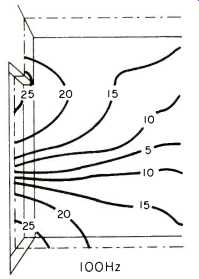
------ Showing sound field penetrating through a door at 100 Hz.
The assembly lines at Videotone were like others we saw--reasonably efficient but (to our eyes) they did things the hard way. For instance, where we use' electric or air-operated tools to insert screws, they use hand drivers.
We use automatic sweep generators and all kinds of production aids to reduce costs but they get the same results in the end because of the relatively low overall production costs.
For instance, girls on the assembly line get 8 to 9 forints an hour for a 48-hour (5 1/2 day) week. At the present rate of 30 forints to the dollar, this is still pretty low but the cost of living, subsidies, and fringe benefits must be taken into account. For those interested, some comparative figures are given at the end.
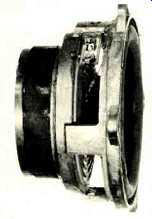
----------- Bass speaker used in the D-132 system.
Several speaker systems, ranging from single units in small enclosures to studio monitors, were demonstrated.
Amplifiers included a McIntosh and a Videotone with an AR turntable and a Pickering V-15 cartridge. At least, I believe it was but I cannot be certain.
Sound quality varied and I hesitate to pass judgment as the program material was not that good. I liked a small system, the 132, which used a 5-in. bass unit with a 4-in. treble speaker.
The bass unit had an unusually large magnet--about 22 ounces, I would guess--and the cone surround was of soft rubber. Flux would be around 12,000 lines and the voice coil looked just over an inch in diameter. At the other extreme, I liked the HEC-11 studio monitor which used a 12-in. bass unit with four 5-in. speakers. Each speaker system had its own built-in 50 W amplifier which incorporated narrow-band adjustable filters. The enclosure itself is vented and the system could handle a great deal of power with low coloration. But the speaker that attracted most interest from our group was the Ultra-1, already available here and in Canada. It uses nine 4 1/2-in. double-cone speakers in an enclosure measuring 13 in. high, 23 in. wide, and 11 in. deep. Eight speakers are mounted at the back and one at the front. However, unlike similar systems, placement is optional and the enclosure can be turned around so the eight units face the front. In other words, the stereo image can be diffuse or sharp according to the room acoustics or listener's preference. Price here is $399.00 a pair and we hope to review this model in the not-too-distant future. Incidentally, Videotone makes a very big range of radio receivers as well as TVs-both monochrome and color.
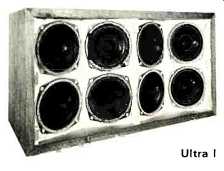
----- Ultra 1
The woodwork factory was set in rural surroundings some miles away and we were all impressed by the high standard of craftsmanship. The majority of cabinets were spray-finished in a high gloss polyethylene which is not too popular here but many other finishes are available.
The Budapest broadcasting network comprises two AM stations in the medium frequency bands, a short wave, and a FM stereo transmitter. We visited the studios near the center of the town and were somewhat surprised to learn that cameras could not be taken inside.
The 1956 revolution started here and it would seem that the authorities are still a little nervous. Be that as it may, we were received with typical Hungarian courtesy and shown the studios and control rooms. The director told us that they recorded in four-channel but had made no broadcasts in this medium so far. Microphones were AKG and Neumann and combinations of spaced and MS were used for quadraphonics.
Studio equipment was EAG with Hungarian EMG tape recorders which looked very similar to the Studer.
Monitor speakers were larger versions of the HEC-11 with a 15-in. bass unit crossing over at 650 Hz to eight 5-in. speakers arranged in two semi-circles.
Qualiton and Hungaroton records have a worldwide reputation and a visit to their studios was one of the highlights of our busy week. Present production is over three million discs a year, of which over 50 per cent is classical. Although accent is on Brahms, Hayden, Bartok, Beethoven, and Mozart, special attention is also given to young contemporary composers.
Up to the present, no quadraphonic discs have been made and I got the impression that the studio manager regarded the whole idea with some suspicion . . . . Recorders were Studio Telefunken but these will be replaced with EAG models later this year. Monitor speakers were Goodmans Tri-Axials mounted in corner enclosures. It was noted that the customary 8 and 16 channel recorder/mixing units were absent, but we were told these would be installed soon. Which may be a pity....
One of the most interesting experiences was watching a musician-engineer (their description) editing pops, crackles, and other noise from a tape.
There he was, sitting at an editing recorder, snipping off tiny pieces of tape and joining up. The tape was an old one--Mengleberg conducting the Amsterdam Concertgebouw playing Bartok's Second Violin Concerto with Zoltan Szekeley. It was made way back in 1939 and the performance was a brilliant one. Although the engineer-musician had a big collection of tape ends, he estimated that the total musical loss would only be a second or two.
(Tape speed was 15 ips.) A very tedious job, though, but rewarding in the artistic sense.
-------
After a brief look at the new sound system at the National Theatre, we went to the Erkel Opera House to hear a Hungarian Operetta by Ferenc Erkel.
I thought the staging was excellent and the orchestra gave a really polished performance. Acoustics were very good and most of the audience got about 90 percent direct sound (sorry about that!). Seats were somewhat cheaper than Broadway standards at 25 cents! So, apart from speeches at the Chamber of Commerce and a visit to a state wine farm, which I refuse to discuss, thus ended a most exhausting but enjoyable week. And now for some conclusions.
*The EAG group already export some 85 per cent of their products but there is no doubt that they could sell studio and communications equipment in the U.S.
*The speaker systems are competitively priced and I am certain that in this area the Hungarians will pose a serious challenge to Japanese and U.S. made products-and possibly to Western European manufacturers too.
*I see no reason why we cannot trade with Hungary. Ultimately this would raise their standard of living with far reaching results. I have the impression that the Hungarians want to look west as well as east. Of course, trade has to be two way, but they are already importing American transistors, instruments, and many other items. The mare dollars they earn, the more they can buy from us.
Finally, I would like to thank Mrs. Edith Vezér of Elektromodul, the Hungarian trading company, and Mr. G. Simonyi from Ultra-Tone of Canada, who organized the trip.
Here are some comparative prices (30 forints to the dollar):
Salaries:
Top managers, executives, chief engineers 5000 forints/mo.
Middle echelon managers, engineers, supervisors 3000 forints/mo.
Semi-qualified engineers, manual workers 2000 forints/mo.
Assembly workers, girls 8 to 9 forints per hour (48 hour week). Prices (selected at random): Cars, VW, 110,00 forints East German (DDR) mini. 60,000 forints TV, B&W, 18 in. 8,500 forints Men's suits 750 forints Leather shoes 500 forints up Suede shoes 250 forints up Cassette recorder 300 forints 12-in records 35 to 60 forints Bread (subsidized) ... 3 forints/kilo Coffee 32 forints/6 oz. app.
Tea 30 forints/6 oz. app.
Beef 50 forints/kilo Dinner in a restaurant .... 25, up to 100 forints for a gourmet meal , One engineer told me that the Hungarian bank has a "car winning" deposit scheme. Participants stand a chance of winning a car by a lottery--but the snag is-no interest is paid! Normal interest rates are 3 per cent for three months minimum, and 5 percent yearly-capitalist thinking which would make Karl Marx turn over in his London grave! Rents are cheap and vacations in group centers are heavily subsidized.
Books are relatively inexpensive, so are theater prices as noted previously.
Finally, some advice for those who will be visiting Hungary.
*The food is magnificent, so don't go if you are on a diet and have no will power.
*The wine is very potent, so be careful.
*Bring Alka-Seltzer tablets.
(Audio magazine, Apr. 1972)
Also see:
= = = =